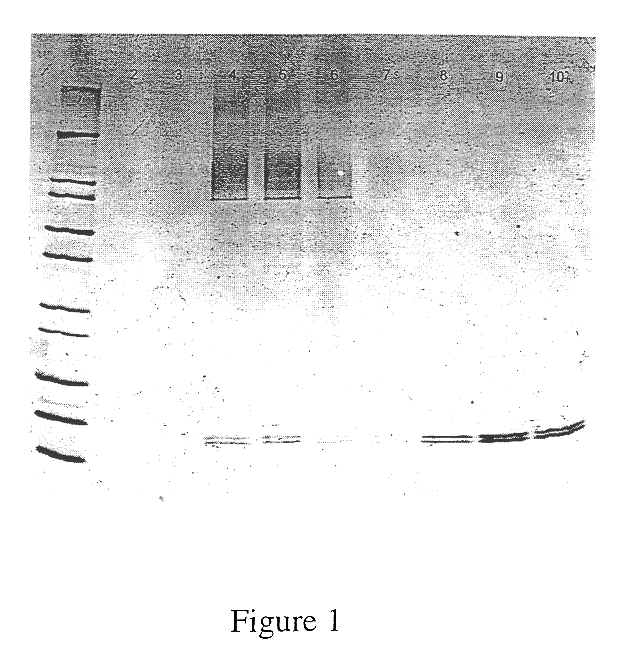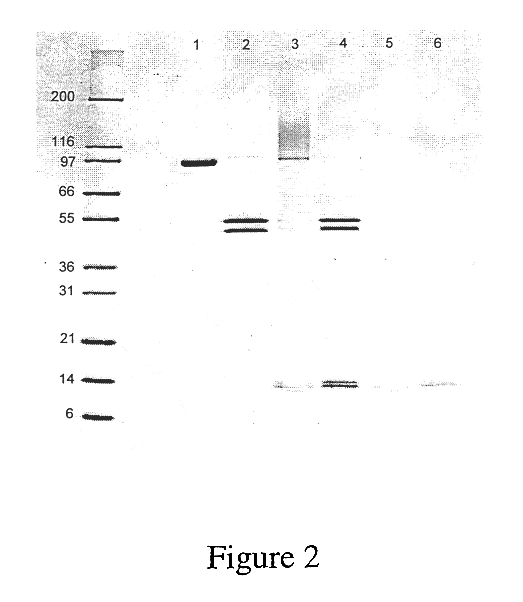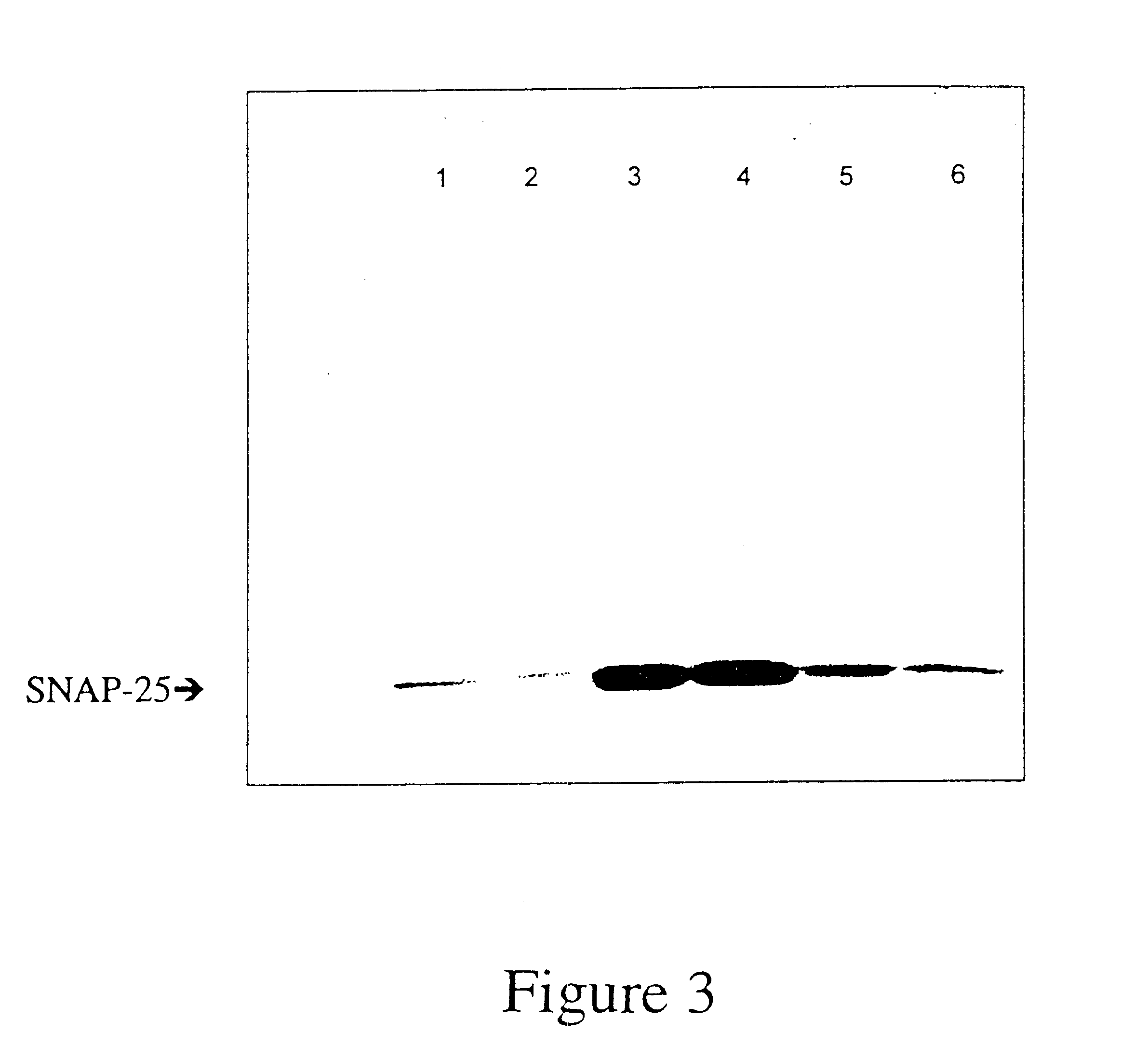Clostridial toxin derivatives able to modify peripheral sensory afferent functions
a technology of clostridial toxin and derivatives, which is applied in the direction of dna/rna fragmentation, drug compositions, peptides, etc., can solve the problems of pain that can continue to be experienced during illness or after, and considerable effort has been expended in finding methods for its alleviation, so as to prevent the transmission of pain signals, reduce the sensation of pain, and prevent the effect of pain signals
- Summary
- Abstract
- Description
- Claims
- Application Information
AI Technical Summary
Benefits of technology
Problems solved by technology
Method used
Image
Examples
example 2
Activities of a Conjugate of NGF and LH.sub.N in PC-12 Cells
PC12 cells are a cell-line of neuroectodermal derivation that are commonly used as a model system for the study of nerve function. As a model system for testing the function of a conjugate of NGF and LH.sub.N they have two necessary features: firstly they are well known to possess cell-surface receptors for NGF that have been shown to be involved in a differentiation process in response to low concentrations of NGF. Secondly they have been shown to contain the exocytotic machinery for neurotransmitter release including, importantly in this example, SNAP-25.
PC12 cells were plated out into a 24-well plate that had been coated with MATRIGEL basement membrane matrix (Collaborative Biomedical Products) at a density of approximately 5.times.10.sup.5 cells per well. After a few days in culture (RPMI 1640 with 2 mM glutamine, 10% horse serum and 5% foetal calf serum, 37.degree. C., 5% CO.sub.2) the medium was replaced with fresh me...
example 3
The Activity of a Conjugate of NGF and LH.sub.N in Primary Cultures of Dorsal Root Ganglion Neurons
The dorsal root ganglia contain the cell bodies of primary nociceptive afferents. It is well established that in primary in vitro cultures of this tissue the neurons retain many of the characteristics of the nociceptive afferents. These characteristics include the ability to release neuropeptides such as substance P in response to chemical stimuli known to cause pain in vivo (e.g. capsaicin). Furthermore the neurons are known to possess receptors for NGF.
Primary cultures of dorsal root ganglion neurons were established following dissociation of the ganglia dissected from rat embryos (embryological age 12-15 days). The cells were plated into 12 well plates at an initial density of 3.times.10.sup.5 cells / well in a medium containing NGF (100 ng / ml). After one day in culture fresh medium containing cytosine arabinoside (10 mM) was added to kill non-neuronal cells. The cytosine arabinoside ...
example 4
The Production of a Chimeric LH.sub.N Whereof the L chain is Derived from BoNT / B and the H.sub.N Fragment from BoNT / A
The H.sub.N fragment of BoNT / A is produced according to the method described by Shone C. C., Hambleton, P., and Melling, J. (1987, Eur. J. Biochem. 167, 175-180) and the L-chain of BoNT / B according to the method of Sathyamoorthy, V. and DasGupta, B. R. (1985, J. Biol. Chem. 260, 10461-10466). The free cysteine on the H.sub.N fragment of BoNT / A is then derivatised by the addition of a ten-fold molar excess of dipyridyl disulphide followed by incubation at 4.degree. C. overnight. The excess dipyridyl disulphide and the thiopyridone by product are then removed by desalting the protein over a PD10 column (Pharmacia) into PBS.
The derivatised H.sub.N is then concentrated to a protein concentration in excess of 1 mg / ml before being mixed with an equimolar portion of L-chain from BoNT / B (>1 mg / ml in PBS). After overnight incubation at room temperature the mixture is separated...
PUM
| Property | Measurement | Unit |
|---|---|---|
| diameter | aaaaa | aaaaa |
| diameter | aaaaa | aaaaa |
| molecular mass | aaaaa | aaaaa |
Abstract
Description
Claims
Application Information
 Login to View More
Login to View More - R&D
- Intellectual Property
- Life Sciences
- Materials
- Tech Scout
- Unparalleled Data Quality
- Higher Quality Content
- 60% Fewer Hallucinations
Browse by: Latest US Patents, China's latest patents, Technical Efficacy Thesaurus, Application Domain, Technology Topic, Popular Technical Reports.
© 2025 PatSnap. All rights reserved.Legal|Privacy policy|Modern Slavery Act Transparency Statement|Sitemap|About US| Contact US: help@patsnap.com



